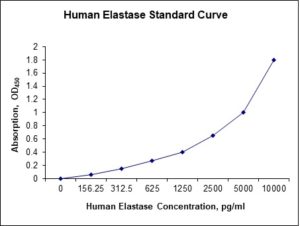Nori Human Neutrophil Elastase ELISA Kit
$461.00 – $832.00
This ELISA kit is for quantification of ELA2 in human. This is a quick ELISA assay that reduces time to 50% compared to the conventional method, and the entire assay only takes 3 hours. This assay employs the quantitative sandwich enzyme immunoassay technique and uses biotin-streptavidin chemistry to improve the performance of the assays. An antibody specific for ELA2 has been pre-coated onto a microplate. Standards and samples are pipetted into the wells and any ELA2 present is bound by the immobilized antibody. After washing away any unbound substances, a detection antibody specific for ELA2 is added to the wells. Following wash to remove any unbound antibody reagent, a detection reagent is added. After intensive wash a substrate solution is added to the wells and color develops in proportion to the amount of ELA2 bound in the initial step. The color development is stopped, and the intensity of the color is measured.
Alternative names for neutrophil elastase: elastase, ELA2, ELANE
This product is for Laboratory Research Use Only not for diagnostic and therapeutic purposes or any other purposes.
- Description
- How Elisa Works
- Product Citation (0)
- Reviews (0)
Description
Nori Human Neutrophil Elastase ELISA Kit Summary
Alternative names for neutrophil elastase: elastase, ELA2, ELANE
| Assay Type | Solid Phase Sandwich ELISA |
| Format | 96-well Microplate or 96-Well Strip Microplate |
| Method of Detection | Colorimetric |
| Number of Targets Detected | 1 |
| Target Antigen Accession Number | P08246 |
| Assay Length | 3 hours |
| Quantitative/Semiquantitative | Quantitative |
| Sample Type | Plasma, Serum, Cell Culture, Urine, Cell/Tissue Lysates, Synovial Fluid, BAL, |
| Recommended Sample Dilution (Plasma/Serum) | No dilution for sample <ULOQ; sufficient dilution for samples >ULOQ |
| Sensitivity | 30 pg/mL |
| Detection Range | 0.156-10 ng/mL |
| Specificity | Human neutrophil elastase |
| Cross-Reactivity | < 0.5% cross-reactivity observed with available related molecules, < 50% cross-species reactivity observed with species tested. |
| Interference | No significant interference observed with available related molecules |
| Storage/Stability | 4 ºC for up to 6 months |
| Usage | For Laboratory Research Use Only. Not for diagnostic or therapeutic use. |
| Additional Notes | The kit allows for use in multiple experiments. |
Standard Curve
Kit Components
1. Pre-coated 96-well Microplate
2. Biotinylated Detection Antibody
3. Streptavidin-HRP Conjugate
4. Lyophilized Standards
5. TMB One-Step Substrate
6. Stop Solution
7. 20 x PBS
8. Assay Buffer
Other Materials Required but not Provided:
1. Microplate Reader capable of measuring absorption at 450 nm
2. Log-log graph paper or computer and software for ELISA data analysis
3. Precision pipettes (1-1000 µl)
4. Multi-channel pipettes (300 µl)
5. Distilled or deionized water
Protocol Outline
1. Prepare all reagents, samples and standards as instructed in the datasheet.
2. Add 100 µl of Standard or samples to each well and incubate 1 h at RT.
3. Add 100 µl of Working Detection Antibody to each well and incubate 1 h at RT.
4. Add 100 µl of Working Streptavidin-HRP to each well and incubate 20 min at RT.
5. Add 100 µl of Substrate to each well and incubate 5-30 min at RT.
6. Add 50 µl of Stop Solution to each well and read at 450 nm immediately.
Background:
Elastase is a serine protease (peptidases) that break down proteins. Some bacteria also produce elastase that is considered a virulence factor.[1,2] Elastase breaks down elastin, an elastic fibre that, together with collagen, determines the mechanical properties of connective tissue. The neutrophil form breaks down the Outer membrane protein A (OmpA) of E. coli and other Gram-negative bacteria. Elastase also has the important immunological role of breaking down Shigella virulence factors. This is accomplished through the cleavage of peptide bonds in the target proteins. The specific peptide bonds cleaved are those on the carboxyl side of small, hydrophobic amino acids such as glycine, alanine, and valine. Elastase is inhibited by the acute-phase protein α1-antitrypsin (A1AT), which binds almost irreversibly to the active site of elastase and trypsin. A1AT is normally secreted by the liver cells into the serum. Alpha-1 antitrypsin deficiency (A1AD) leads to uninhibited destruction of elastic fibre by elastase; the main result is emphysema. The rare disease cyclic neutropenia (also called “cyclic hematopoeiesis”) is an autosomal dominant genetic disorder characterised by fluctuating neutrophil granulocyte counts over 21-day periods. During neutropenia, patients are at risk for infections. In 1999, this disease was linked to disorders in the ELA-2/ELANE gene.[3] Other forms of congenital neutropenia also appear to be linked to ELA-2 mutations. Neutrophil elastase is responsible for the blistering in bullous pemphigoid, a skin condition, in the presence of antibodies. Elastase has been shown to disrupt tight junctions, cause proteolytic damage to tissue, break down cytokines and alpha proteinase inhibitor, cleave immunoglobulin A and G (IgA, IgG), and cleave both C3bi, a component of the complement system, and CR1, a receptor on neutrophils for another complement molecule involved in phagocytosis. The cleavage of IgA, IgG, C3bi, and CR1 contributes to a decrease of the ability of neutrophils to kill bacteria by phagocytosis.
References
- Bever,R.A. and Iglewski,B.H. (1988) J. Bacteriol. 170 (9), 4309-4314.
- Rust,L., et al. (1996) J. Bacteriol. 178 (4), 1134-1140.
- Horwitz M, et al. (1999). Nat. Genet. 23 (4): 433–6.
Be the first to review “Nori Human Neutrophil Elastase ELISA Kit”
You must be logged in to post a review.




























Reviews
There are no reviews yet.